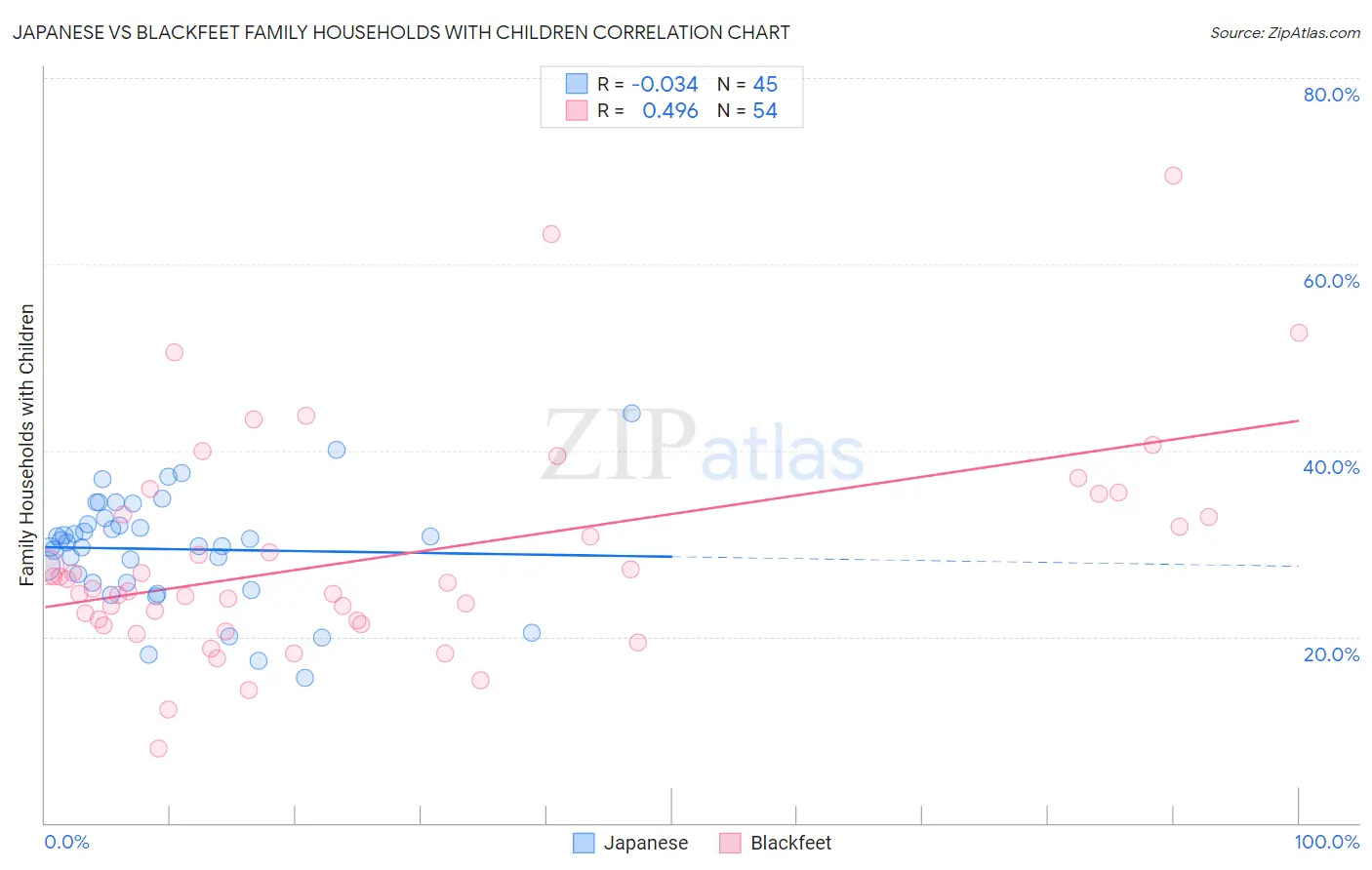Japanese vs Blackfeet Family Households with Children
COMPARE
Japanese
Blackfeet
Family Households with Children
Family Households with Children Comparison
Japanese
Blackfeet
29.4%
FAMILY HOUSEHOLDS WITH CHILDREN
100.0/ 100
METRIC RATING
31st/ 347
METRIC RANK
27.5%
FAMILY HOUSEHOLDS WITH CHILDREN
54.3/ 100
METRIC RATING
171st/ 347
METRIC RANK
Japanese vs Blackfeet Family Households with Children Correlation Chart
The statistical analysis conducted on geographies consisting of 249,052,059 people shows no correlation between the proportion of Japanese and percentage of family households with children in the United States with a correlation coefficient (R) of -0.034 and weighted average of 29.4%. Similarly, the statistical analysis conducted on geographies consisting of 309,442,274 people shows a moderate positive correlation between the proportion of Blackfeet and percentage of family households with children in the United States with a correlation coefficient (R) of 0.496 and weighted average of 27.5%, a difference of 7.2%.

Family Households with Children Correlation Summary
| Measurement | Japanese | Blackfeet |
| Minimum | 15.6% | 8.0% |
| Maximum | 44.0% | 69.5% |
| Range | 28.4% | 61.5% |
| Mean | 29.4% | 28.6% |
| Median | 30.1% | 25.4% |
| Interquartile 25% (IQ1) | 25.8% | 21.7% |
| Interquartile 75% (IQ3) | 32.4% | 33.1% |
| Interquartile Range (IQR) | 6.6% | 11.4% |
| Standard Deviation (Sample) | 5.9% | 11.7% |
| Standard Deviation (Population) | 5.9% | 11.6% |
Similar Demographics by Family Households with Children
Demographics Similar to Japanese by Family Households with Children
In terms of family households with children, the demographic groups most similar to Japanese are Immigrants from Yemen (29.4%, a difference of 0.060%), Yuman (29.5%, a difference of 0.14%), Samoan (29.5%, a difference of 0.18%), Bolivian (29.5%, a difference of 0.18%), and Venezuelan (29.4%, a difference of 0.26%).
| Demographics | Rating | Rank | Family Households with Children |
| Guamanians/Chamorros | 100.0 /100 | #24 | Exceptional 29.7% |
| Immigrants | Latin America | 100.0 /100 | #25 | Exceptional 29.7% |
| Sri Lankans | 100.0 /100 | #26 | Exceptional 29.5% |
| Immigrants | Vietnam | 100.0 /100 | #27 | Exceptional 29.5% |
| Samoans | 100.0 /100 | #28 | Exceptional 29.5% |
| Bolivians | 100.0 /100 | #29 | Exceptional 29.5% |
| Yuman | 100.0 /100 | #30 | Exceptional 29.5% |
| Japanese | 100.0 /100 | #31 | Exceptional 29.4% |
| Immigrants | Yemen | 100.0 /100 | #32 | Exceptional 29.4% |
| Venezuelans | 100.0 /100 | #33 | Exceptional 29.4% |
| Immigrants | Bolivia | 100.0 /100 | #34 | Exceptional 29.3% |
| Immigrants | Sierra Leone | 100.0 /100 | #35 | Exceptional 29.3% |
| Immigrants | Venezuela | 100.0 /100 | #36 | Exceptional 29.3% |
| Immigrants | Cameroon | 100.0 /100 | #37 | Exceptional 29.2% |
| Koreans | 100.0 /100 | #38 | Exceptional 29.2% |
Demographics Similar to Blackfeet by Family Households with Children
In terms of family households with children, the demographic groups most similar to Blackfeet are Israeli (27.5%, a difference of 0.010%), Cherokee (27.5%, a difference of 0.050%), Immigrants from Argentina (27.5%, a difference of 0.050%), Seminole (27.5%, a difference of 0.060%), and White/Caucasian (27.4%, a difference of 0.090%).
| Demographics | Rating | Rank | Family Households with Children |
| Immigrants | Hong Kong | 64.9 /100 | #164 | Good 27.5% |
| Immigrants | South Africa | 61.3 /100 | #165 | Good 27.5% |
| Immigrants | Nonimmigrants | 61.2 /100 | #166 | Good 27.5% |
| Dominicans | 61.1 /100 | #167 | Good 27.5% |
| Immigrants | Kuwait | 60.9 /100 | #168 | Good 27.5% |
| Seminole | 56.9 /100 | #169 | Average 27.5% |
| Cherokee | 56.7 /100 | #170 | Average 27.5% |
| Blackfeet | 54.3 /100 | #171 | Average 27.5% |
| Israelis | 53.9 /100 | #172 | Average 27.5% |
| Immigrants | Argentina | 52.2 /100 | #173 | Average 27.5% |
| Whites/Caucasians | 50.0 /100 | #174 | Average 27.4% |
| British | 49.9 /100 | #175 | Average 27.4% |
| Immigrants | China | 49.6 /100 | #176 | Average 27.4% |
| Ugandans | 49.2 /100 | #177 | Average 27.4% |
| Spanish Americans | 48.9 /100 | #178 | Average 27.4% |